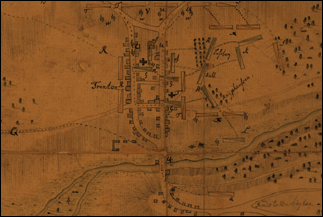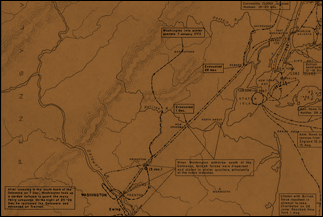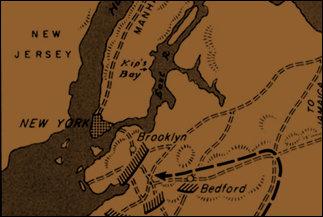Washington's Retreat
After losing New York and in Fort Lee, and narrowly escaping capture, Washington lead a continental army on the verge of collapse. Preserving what remained of his army he retreated strategically across NJ and into Pennsylvania. Although he was wary of a possible attack on Philadelphia once the Delaware froze over, Washington had surmised correctly that the British would seek winter quarters. This gave Washington the chance to regroup, gain reinforcements and plan his next move.
Battle of Trenton
Dec. 22 1776: Washington had 4707 troops fit for duty.
Washington decided to stage a predawn attack set for December 26 on Johann Rall's isolated Hessian garrison at Trenton. Their exposed position and having gained intelligence about Christmas being heartily celebrated into the late hours influenced this choice greatly.
The strategy was to begin close to 11:00PM Christmas night. The bulk of the attack would be carried out by 3 columns with about 2400 veteran troops and 18 cannons. The combined troops of Maj. General. John Sullivan and Nathanael Greene would cross the Delaware River at McKonkey's Ferry, approximately 9 miles away from Trenton, and ambush the Hessians from the north.
The American plan relied on launching coordinated attacks from three directions. General John Cadwalader would launch a diversionary attack against the British garrison at Bordentown, New Jersey, to block off reinforcements. General James Ewing would take 700 militia across the river at Trenton Ferry, seize the bridge over the Assunpink Creek and prevent enemy troops from escaping. The main assault force of 2,400 men would cross the river 9 miles (14 km) north of Trenton and split into two groups - one under Greene and one under Sullivan - to launch a pre-dawn attack. Sullivan would attack the town from the south and Greene from the north. Depending on the success of the operation, the Americans would possibly follow up with separate attacks on Princeton and New Brunswick.
The counterstrike intended to cut off the Hessian escape was two-fold. Brigade General James Ewing was to lead around 1000 militia at the Trenton Ferry to cut off the southbound escape route, and take control of Assunpink Creek's bridge to prevent enemies from escaping. Col. John Cadwalader had 2000 men to lead across the river at Bordentown to cause a diversion with an attack upon the stationed garrison.
During the week before Christmas, American advanced parties had begun to ambush enemy cavalry patrols, capturing dispatch riders and attacking Hessian pickets. This became so effective that the Hessian commander was forced to send 100 infantry and an artillery detachment to protect his letter to the British commander at Princeton. Washington ordered that Ewing and his Pennsylvania militia try to gain information on Hessian movements and designs. Instead of doing this, Ewing launched three successful raids across the river. On December 17 and 18th they attacked a Jagers outpost and on the 21st, set fire to several houses.[10] Washington also ordered that all possible crossings near their encampment on the Delaware were to be watched day and night, as he believed that Howe would launch an attack on Philadelphia if the river froze over.
On December 20, 2,000 men arrived to join Washington's army. They were under the command of Charles Lee and had been retreating across northern New Jersey when Lee was captured. That same day, an additional 800 troops arrived from Fort Ticonderoga under the command of Horatio Gates.
Hessian Moves
On December 14, the Hessians arrived in Trenton. Trenton had two main streets, King (now Warren) Street and Queen (now Broad) Street, and the town consisted of about 100 houses. Carl von Donop, Rall's superior, had marched south to Mount Holly on December 22 to deal with the resistance in New Jersey, and clashed with the New Jersey militia there on December 23.
Donop, who despised Rall, was reluctant to give command of Trenton to him. Rall was known to be loud, and a drunk, and was unacquainted with the language, but he was also a 56-year soldier with a great deal of battle experience. He had requested reinforcements and been turned down by British commander General James Grant. Grant regarded the Americans with great disdain and sent no reinforcements. Despite his experience, the Hessians at Trenton were not fond of their commander. They believed that he was too nice, and was not ruthless enough to be a successful military commander. His officers complained saying "His love of life was too great, a thought came to him, then another, so he could not settle on a firm decision ..." Rall avoided hard work and had little concern for his troops' comfort.
Trenton had no walls or fortifications, which was common with American settlements. Some of the Hessian officers advised Rall to fortify the town, and two of the engineers and advised that a redoubt be constructed at the upper end of town, and that fortifications should be built along the river. The engineers went as far as to draw up plans, but Rall disagreed with them. When Rall was once again urged to fortify the town, he replied by saying "Shit upon shit! Let them come...We will go at them with the bayonet."
As Christmas approached, Loyalists came to the town with reports that the Americans were planning something. Even some American deserters told the Hessians that rations were being prepared to cross the river. Rall publicly dismissed all of this talk as nonsense, but privately in letters to his superiors, he expressed that he was worried of an imminent attack. He wrote to Donop that he was "liable to be attacked an any moment." Rall said that Trenton was "indefensible" and asked that British troops establish a garrison in Maidenhead, which was closer to Trenton and would help keep the roads open from Americans. His request was declined. As the Americans began to disrupt the Hessian supply lines, the officers started to share Rall's fears. One wrote "We have not slept one night in peace since we came to this place." On December 22, a spy reported to Grant that Washington had called a council of war; Grant told Rall to "be on your guard."
The main force of 1,500 men was divided into three regiments: Knyphausen, Lossberg and Rall. That night they had not sent out any patrols because of the severe weather.
The Brilliance of Washington's Strategy
Our History books cite "The Ten Crucial Days" between the end of December 1776 and the first week of January 1777 in the American Revolution as the turning point on our road to freedom. The decisive battles fought between the Continental Army under George Washington and the British army were more than a counter strike - They were affirmations that American could win, if we were willing to fight!
Washington realized then what we know now. He realized that his previous defeats were more significant to the will or the revolution then they were strategically. He knew that a victory would embolden his army and in fact the entire revolution. Washington saw that opportunity in Trenton. He seized the day and boldly marched the Road to Freedom.




